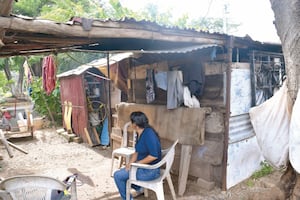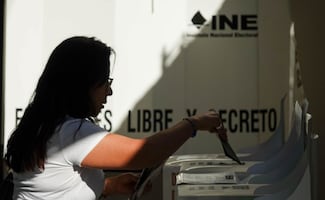Más Información

Marco Rubio destaca labor de seguridad de México; "están haciendo más que nunca en su historia", afirma

Sin garras y con lesiones Profepa rescata a león amarrado a un árbol en Nayarit; inician investigación

Inegi oficializa creación de nueva instancia para medir la pobreza, tras desaparición del Coneval; crea una Dirección General

Juez frena revocación de testigo protegido a Raúl Rocha; da medida cautelar a dueño de Miss Universo
“I have not died and, moreover, I have something to live for; that something is painting.” Frida Kahlo told those words to her mother when she was able to see her weeks after the accident that changed her body, her work, and her life. It took place on this day 95 years ago,
It was writer and art critic Raquel Tibol who recovered these words; they were told to her by Kahlo herself. So is told in the book Frida Kahlo. An Open Life . In the award ceremony for the book, Tibol – who arrived in Mexico as Diego Rivera’s secretary in May 1953 - describes the most important facts of the “short, extraordinary, and rich” live of Frida Kahlo and highlights the “serious accident” that took place on September 17, 1925, when the painter was 18 years old, an accident that definitely changed her backbone, pelvis, and matrix.
In the biography Frida , Hayden Herrera also spends a chapter on the event that “transformed” Firda’s life and asserts: “Since the accident , pain and strength, became the main topics of her life.”
The pain was constant since the accident. Frida had already suffered from the effects of poliomyelitis she contracted when she was six years old, and that caused her right leg to be a bit shorter and thinner; she had overcome it. The consequences of the accident determined her life and the art she was going to create. It was not usual for any artist – even less for a woman in Latin America – to express emotional and physical experiences. Pain in Frida’s works is not only a topic; neither is the physical aspect. It is something more complex, and that is where the richness of her art stems from.
Recommended:
A golden rainy afternoon
It was Thursday, a day after the Mexican Independence Day, and it had rained. Frida and her friend Alejandro Gómez Arias were on their way back to Coyoacán. At the crossroad of Cuahutemotzón and 5 de Febrero, they had just gotten on a second bus since the young woman had lost her umbrella and had gotten off the first one to look for it. They sat down together. Minutes after, a trolley crashed with the bus, dragged it against a wall, and ran over a lot of people. Frida was severely injured , so much that people thought she and another injured woman, both of whom were taken to the Red Cross, were going to die, as said EL UNIVERSAL a day after.
“It tore me down” was a phrase used by Kahlo to Tibol. Alejandro’s narration was marked by a golden halo, the gold that surrounded Frida’s naked body; that is why many of those who saw the accident talked about “the dancer.”
In the artist’s clinical story, which was written in 1946 by German doctor Henriette, and that was reproduced by Raquel Tibol in her book, it is reported that the accident caused “fracture of the third and fourth lumbar vertebras, three fractures in the pelvis, 11 fractures in the right food, dislocation of the left elbow, penetrating injury in the abdomen caused by an iron tube that entered through the left hip and exited through the sex tearing the left labium. Acute peritonitis. Cystitis with cannulation for several days.”
The team of the Archive and Collection of the Frida Kahlo Museum – the house where the artist was born and where she lived and died – has documents the location of the accident in the corner of Cuauhtemotzín street, near the Tlalpan Road, based on the plans of the trolleys and railways of the time.
The Museum has also documented that are materials related to the tragic event. The most important is a pencil drawing by Frida Kahlo that is preserved at the Dolores Olmedo Museum and that belongs to the collection of Juan Coronel Rivera. The drawing shows the crash of the trolley and the bus on the background and her in a hospital bed in the foreground. It is dated September 17, 1926, a year after the accident.
Recommended:
There is also a votive offering, from 1943, that represents the accident; it belongs to a private collection; the person who ordered the offering is unknown.
The Museum has a picture taken by the artist herself, in black and white, who represented the accident with toys.
Many essential Kahlo paintings are linked to pain matters and the more than 20 surgeries she had to undergo, such as “The Broken Column” that is guarded by the Dolores Olmedo Museum; the painting “Tree of Hope” also refers to the medical procedures.
One of the most famous quotes by the Mexican artist says “I suffered two serious accidents in my life, one in which a bus threw me to the ground… The other accident is Diego.”
The collection of the Frida Kahlo Museum also has the corsets and special shoes the painter had to use because of the consequences to her body.
In her book, Raquel Tibol writes that death “looked for Frida” some times; the clinical story she reproduced lists abortions in 1929, 1932, and 1934, surgeries in her right foot, the permanent and serious back pains, the consequences that appeared with time: ulcers, fungus, fatigue, pain on her right leg, the iron and plaster corsets, weight loss, surgeries, blood transfusions. Tibol also mentions the consumption of cognac, depressions, suicide attempts. The clinical story ends in 1946, that is why it does not mention the amputation of her toes in 1950 and one of her legs in 1953.
Recommended:
The two stories
In her books, Raquel Tibol and Hayden Herrera include the original sources of the story. Tibol, the artist’s testimony; Herrera quotes, among other sources, Alejandro’s testimony. Both books also gather letters she wrote to him from the Red Cross, where she was for around a month.
In 1953, a year before her death, the painter told Tibol about her life and that narration is in the chapter “Frida by Frida.” The story of the accident contains small mistaken data, such as the number of months she was in the Red Cross. This is what the artist told Tibol:
“Buses in my time were completely weak; they were first being driven and were popular; trolleys were empty. I got on the bus with Alejandro Gómez Arias. I sat on the edge, next to the handrail, and Alejandro [sat] next to me. Moments after, the bus crashed with a train from the Xochimilco line. The train crashed the bus against the corner. It was a weird crash; it was not violent but deaf, slow, and mauled everyone. And me the worst. I remembered it took place exactly on September 17, 1925, the next day after the celebrations of the 16th. I was 18 years old back then, but I seemed much younger, even younger than Cristi, who is 11 months younger than me.
“The crash happened little after getting on the bus. We had taken another bus before, but I had lost an umbrella; we got off to look for it and that’s how we came to get on the bus that tore me down. The accident took place in the corner in front of the San Juan market, just in front. The trolley was moving slow but our bus driver was a very anxious man. When it turned, the trolley dragged the bus against the wall.
“I was a smart but impractical young woman despite the freedom I had achieved. Maybe that’s why I didn’t measure the situation nor did I sensed the kind of injuries I had. The first I thought was on a balero with nice colors I had purchased that day and that I had with me. I tried to look for it thinking there were no major consequences.
Recommended:
“It’s a lie you notice the crash; it’s a lie you cry. There were no tears from me. The crash moved us forward and the handrail went through me as a sword does with a bull. A man saw me with a tremendous hemorrhage, lifted me up, and put me in a pool table until the Red Cross went for me.
“I lost my virginity, my kidney was softened, I could not pee, and what hurt me the most was my column. No one paid attention to me. Moreover, there were not x-rays. I sat as I could and told the Red Cross to call my family. Matilde read the news in the newspaper and was the first to arrive and was by my side for three months; day and night. My mother was left speechless for a month due to the shock and did not go to visit me. My father was so sad that he got sick and I was only able to see him after 20 days.
“I was three months in the Red Cross. The Red Cross was very poor. They had us in a kind of awful shed; food was horrible and could barely be eaten. A single nurse looked after 25 patients. It was Matilde who cheered me up: She told me jokes. She was fat and a bit ugly but she had a great sense of humor; she made laugh everyone in the room. She knitted and helped the nurse to attend to the patients.
“My high school classmates went to check on me. They brought me flowers and tried to distract me. They were the members of ‘Los Cachuchas,’ a group of boys whose only female member was me. One of them gave me a doll I still have. I have that doll and many other things. I love things, life, and people a lot. I don’t want people to die. I’m not afraid to die but I want to live. Pain is what I can’t bear.
“As soon as I saw my mother, I told her, ‘I have not died and, moreover, I have something to live for, that something is painting .’ Since I had to lie down with a plaster corset, that went from the collarbone to the pelvis, my mother devised a gadget from which hanged the wood I used to give support to the papers. It was she who had the idea to roof my bed in a Renaissance style. She put a canopy and a mirror in the roof so that I could see me and use my image as a model.”
Recommended:
Alejandro’s story
In the fourth chapter of her book, “The Accident and the After-Effects,” Hayden Herrera quotes Alejandro Gómez Arias:
“The two-wagon trolley slowly approached the bus and hit it in the middle, slowly pushing it. The bus had a weird elasticity. It curved more and more but did not tear down for the moment. It was a bus with long benches to the sides. I remember that for a moment, my knees touched those of the person sitting in front of me; I was next to Frida. When the bus reached its maximum flexibility, it exploded in thousands of pieces and the trolley moved forward. It ran over a lot of people.
“I was left beneath the train. Frida didn’t. However, one of the iron bars of the train, the handrail, broke and crossed Frida from one side to the other through the pelvis. As soon as I was able to get up, I went from beneath the train. I did not suffer any injury, only bruises. Naturally, looking for Frida was the first thing I did.
“Something weird happened, Frida was completely naked. The crash took off her clothes. Someone from the bus, maybe a painter, was carrying a package of gold powder that got broken and covered the bloody body of Frida. As soon as people saw her, they yelled: ‘The dancer! The dancer!’ Because of the gold in her bloody body, they thought she was a dancer.
“I picked her up, I was a strong young man back then and, with horror, I noticed she had a piece of iron in her body. A mand said: ‘Let’s take it out!' He put his knee in Frida’s body and said ‘Let’s pull it out.” When he pulled it, Frida screamed so loud that no one heard the siren of the Red Cross ambulance when it arrived. Before it appeared, I picked up Frida and put her on the sideboard of a pool. I took off my jacket and covered her with it. I thought she was going to die. Two or three people died in the scene, and others did later on.
“The ambulance arrived and took her to the Red Cross hospital, which back then was located in San Jerónimo street, some blocks away from the accident. Frida’s condition was so serious that doctors didn’t think they could save her. They thought she was going to die on the operating table.
“There, she had surgery for the first time. During the first month, there was no certainty about her going to survive .”
Recommended:
In one of the letters Frida wrote to Alejandro from the hospital, she told him, “In this hospital, death dances around my bed at night. “There’s no cure” and “I must endure it” were phrases she mentioned in other letters. Frida Kahlo suffered and went through pain, and without ever stopping feeling it, art was her cure and essence.
mp
Noticias según tus intereses
[Publicidad]
[Publicidad]










